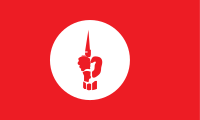
Back موكتي باهيني Arabic মুক্তিবাহিনী (বাংলাদেশ) AS মুক্তিবাহিনী Bengali/Bangla Mukti Bahini French मुक्तिवाहिनी HI Mukti Bahini ID 동파키스탄 해방군 Korean മുക്തി ബാഹിനി Malayalam मुक्ती बाहिनी MR मुक्तिवाहिनी NE
The Mukti Bahini (Bengali: মুক্তি বাহিনী, romanized: Mukti Bahinee), also known as the Bangladesh Forces, was a big tent armed guerrilla resistance movement consisting of the Bangladeshi military personnel, paramilitary personnel and civilians during the Bangladesh Liberation War that transformed East Pakistan into Bangladesh in 1971.[3] They were initially called the Mukti Fauj.[4]
On 7 March 1971, Sheikh Mujibur Rahman issued a call to the people of East Pakistan to prepare themselves for an all-out struggle.[5] Later that evening resistance demonstrations began,[5] and the West Pakistani military began a full-scale retaliation with Operation Searchlight in the early hours of 26 March 1971, which continued through May 1971.[5][6][7]
A formal military leadership of the resistance was created in April 1971 under the Provisional Government of Bangladesh. The military council was headed by General M. A. G. Osmani[8] and eleven sector commanders.[9] The Bangladesh Armed Forces were established on 4 April 1971. The most prominent divisions of the Mukti Bahini were the Z Force led by Major Ziaur Rahman, the K Force led by Major Khaled Mosharraf and the S Force led by Major K M Shafiullah. Awami League student leaders formed militia units, including the Mujib Bahini, the Kader Bahini and Hemayet Bahini.[9] The Communist Party of Bangladesh, led by Comrade Moni Singh, and activists from the National Awami Party also operated several guerrilla battalions.[10]
Using guerrilla warfare tactics, the Mukti Bahini secured control over large parts of the Bengali countryside. It conducted successful "ambush and sabotage" campaigns,[11] and included the nascent Bangladesh Air Force and the Bangladesh Navy. The Mukti Bahini received training and weapons from India,[12] where people in West Bengal shared a common Bengali ethnic and linguistic heritage with East Pakistan.[13]
During the Indo-Pakistani War of 1971, the Mukti Bahini became part of the Bangladesh-India Allied Forces.[14] It was instrumental in securing the Surrender of Pakistan and the liberation of Dhaka and other cities in December 1971.[14][15]
- ^ "Mukti Bahini: Guerilla Warfare". Archived from the original on 1 September 2024. Retrieved 29 August 2024.
- ^ Lal, PC (1986). My Years with the IAF. Lancer International. p. 153. ISBN 978-1-935501-75-6.
- ^ Alagappa, Muthiah, ed. (2001). Coercion and governance : the declining political role of the military in Asia. Stanford University Press. p. 212. ISBN 0-8047-4227-8.
- ^ Ahmed, Helal Uddin (2012). "Mukti Bahini". In Islam, Sirajul; Jamal, Ahmed A. (eds.). Banglapedia: National Encyclopedia of Bangladesh (Second ed.). Asiatic Society of Bangladesh. Archived from the original on 3 July 2015. Retrieved 4 December 2015.
- ^ a b c Abu Md. Delwar Hossain (2012), "Operation Searchlight", in Sirajul Islam and Ahmed A. Jamal (ed.), Banglapedia: National Encyclopedia of Bangladesh (Second ed.), Asiatic Society of Bangladesh, archived from the original on 5 October 2021, retrieved 22 April 2016
- ^ Benvenisti, Eyal (2012) [First published 1992]. The International Law of Occupation (2nd ed.). Oxford University Press. p. 189. ISBN 978-0-19-163957-9.
Although India portrayed itself at that time as neutral, the Indian government in fact nurtured the Bangladeshi Mukti Bahini (liberation army) guerrillas and the Awami League. India supplied them with arms, ammunition, and logistical support, and permitted them to recruit and train volunteers, most of the refugees, on Indian soil.
- ^ Jahan, Rounaq (February 1973). "Bangladesh in 1972: Nation Building in a New State". Asian Survey. 13 (2): 199–210. doi:10.2307/2642736. JSTOR 2642736.
- ^ Unconventional Warfare in South Asia: Shadow Warriors and Counterinsurgency, Gates and Roy, Routledge, 2016
- ^ a b The Colonel Who Would Not Repent: The Bangladesh War and Its Unquiet Legacy, Salil Tripathi, Yale University Press, 2016, p. 146.
- ^ Communist and Marxist parties of the world, Charles Hobday, Longman, 1986, p. 228
- ^ Jamal, Ahmed Abdullah (October–December 2008). "Mukti Bahini and the Liberation War of Bangladesh: A Review of Conflicting Views" (PDF). Asian Affairs. 30 (4). Centre for Development Research, Bangladesh. Archived from the original (PDF) on 3 January 2015.
- ^ Cite error: The named reference
Time Photo Gallerywas invoked but never defined (see the help page). - ^ Fraser, Bashabi (2008). Bengal Partition Stories: An Unclosed Chapter. Anthem Press. p. 7. ISBN 978-184331-299-4.
- ^ a b Stanton, Andrea L. (2012). Cultural Sociology of the Middle East, Asia, and Africa: An Encyclopedia. Sage. p. 170. ISBN 9781412981767. Archived from the original on 7 March 2023. Retrieved 22 April 2016.
- ^ "The battle for Bangladesh". The Daily Star. 16 December 2013. Archived from the original on 10 May 2017. Retrieved 22 April 2016.

